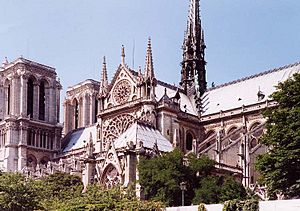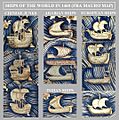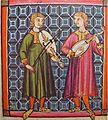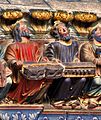High Middle Ages facts for kids

The High Middle Ages was a very important time in European history. It lasted for about 300 years, from the 11th century to the end of the 13th century (from the year 1000 to 1299 AD). This period came after the Early Middle Ages (which ended around 1000 AD). After the High Middle Ages, the Late Middle Ages began, lasting until about 1500 AD. During the High Middle Ages, Europe saw many big changes and new ideas.
Contents
What Happened During the High Middle Ages?
The High Middle Ages was a time of growth and new beginnings in Europe. People often call it a period of "rebirth" because so many things improved.
Population Growth and Farming
More people were born during this time, so the population grew a lot. Farmers learned new ways to grow food, like using better plows and rotating crops. This meant they could grow more food, which helped more people survive and thrive.
New Towns and Trade
As farming got better, not everyone had to work on farms. Many people moved to new towns and cities that were growing. These towns became centers for trade, where people bought and sold goods. New trade routes opened up, connecting different parts of Europe and even other continents.
The Rise of Universities
One of the most exciting developments was the start of universities. Before this, learning mostly happened in monasteries. But now, students could go to places like the University of Paris or Oxford to study law, medicine, and theology. This helped spread knowledge and new ideas.
Building Great Cathedrals
This period is famous for its amazing cathedrals. Many huge and beautiful churches were built, like the Notre Dame Cathedral in Paris. These buildings were often made in the Gothic style, with tall spires, pointed arches, and large stained-glass windows. They showed how skilled builders and artists were at the time.
The Crusades
The High Middle Ages also saw the Crusades. These were a series of religious wars where European Christians tried to take back control of the Holy Land (especially Jerusalem) from Muslim rule. While they didn't always succeed, the Crusades had a big impact on trade, travel, and how different cultures interacted.
New Ways of Thinking
Thinkers like Thomas Aquinas developed new ways to combine faith and reason. This led to a deeper understanding of philosophy and science. New inventions also appeared, like eyeglasses, which helped people read and work more easily.
Images for kids
-
After the successful siege of Jerusalem in 1099, Godfrey of Bouillon, leader of the First Crusade, became the first ruler of the Kingdom of Jerusalem.
-
Detail of a portrait of Hugh de Provence (wearing spectacles), painted by Tommaso da Modena in 1352
-
Ships of the world in 1460, according to the Fra Mauro map.
-
Interior of Nôtre Dame de Paris
-
John the Apostle and Marcion of Sinope in an Italian illuminated manuscript, painting on vellum, 11th century
-
Musicians playing the Spanish vihuela, one with a bow, the other plucked by hand, in the Cantigas de Santa Maria of Alfonso X of Castile, 13th century
-
Men playing the organistrum, from the Ourense Cathedral, Spain, 12th century
See also
 In Spanish: Plena Edad Media para niños
In Spanish: Plena Edad Media para niños










